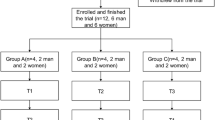Abstract
Background and Objective
101BHG-D01 nasal spray is the first novel long-acting cholinergic M receptor antagonist under development to treat rhinorrhea in rhinitis. This first-in-human study aimed to evaluate the safety, tolerability, and pharmacokinetics of 101BHG-D01 nasal spray following single intranasal doses in healthy Chinese subjects.
Methods
A randomized, double-blind, placebo-controlled, single-dose escalation study was conducted in healthy Chinese volunteers after intranasal doses of 101BHG-D01 nasal spray or placebo ranging from 40 µg to 960 µg (total of six doses). Blood samples were collected at scheduled time points, and plasma concentrations were determined using a validated high-performance liquid chromatography–tandem mass spectrometry (HPLC-MS/MS) method. A non-compartmental method was used to calculate the main pharmacokinetic parameters, including the area under the plasma concentration–time curve from time zero to the time of the last measurable concentration (AUC0–t), the area under the plasma concentration–time curve from time zero to infinity (AUC0–∞), the maximum plasma concentration (Cmax), the time to maximum plasma concentration (Tmax), and the elimination half-life (t1/2). Safety was evaluated by monitoring adverse events, laboratory assays, vital signs, physical examinations, 12-lead electrocardiograms (ECGs), anterior rhinoscopy, ophthalmic examination, and ambulatory ECG monitoring.
Results
Following single intranasal dosing, 101BHG-D01 was rapidly absorbed with a median Tmax of 0.34–0.50 h and eliminated slowly with a mean t1/2 ranging from 4.29 to 46.76 h for different dose groups. The Cmax and AUC of 101BHG-D01 increased linearly across the examined dose range of 40–960 µg. 101BHG-D01 nasal spray was well tolerated, all AEs were mild, and no serious adverse events occurred during the study.
Conclusions
101BHG-D01 nasal spray was safe and well tolerated in healthy Chinese subjects when administered intranasally in single escalating doses. The mean Cmax and AUC increased proportionally to the studied dose. The pharmacokinetic, safety, and tolerability profiles of 101BHG-D01 nasal spray indicate that it is a good candidate for further development as a treatment for rhinorrhea in rhinitis.




Similar content being viewed by others
References
Brozek JL, Bousquet J, Agache I, et al. Allergic rhinitis and its Impact on asthma (ARIA) guidelines—2016 revision. J Allergy Clin Immunol. 2017;140(4):950–8.
Wallace D, Dykewicz M. The diagnosis and management of rhinitis: an updated practice parameter. J Allergy Clin Immunol. 2008;122(Suppl 2):S1–84.
Katelaris CH, Lee BW, Potter PC, et al. Prevalence and diversity of allergic rhinitis in regions of the world beyond Europe and North America. Clin Exp Allergy. 2012;42(2):186–207.
Grossman J, Banov C, Boggs P, et al. Use of ipratropium bromide nasal spray in chronic treatment of nonallergic perennial rhinitis, alone and in combination with other perennial rhinitis medications. J Allergy Clin Immunol. 1995;95(5 Pt 2):1123–7.
Haddad EB, Pate H, Keeling JE, et al. Pharmacological characterization of the muscarinic receptor antagonist, glycopyrrolate, in human and guinea-pig airways. Br J Pharmacol. 1999;127(2):413–20.
Singh S, Loke YK, Furberg CD. Inhaled anticholinergics and risk of major adverse cardiovascular events in patients with chronic obstructive pulmonary disease: a systematic review and meta-analysis. JAMA. 2009;301(12):1227–30.
Sun LN, Ding L, Wang YQ, et al. Pharmacokinetics, safety and tolerability of bencycloquidium bromide, a novel selective muscarinic M1/M3 receptor antagonist, after single and multiple intranasal doses in healthy Chinese subjects: an open-label, single-center, first-in-human study. Drugs RD. 2012;12(1):17–28.
US Food and Drug Administration. Guidance for industry: estimating the maximum safe starting dose in initial clinical trials for therapeutics in adult healthy volunteers. Available from: https://www.fda.gov/regulatory-information/search-fda-guidance-documents/estimating-maximum-safe-starting-dose-initial-clinical-trials-therapeutics-adult-healthy-volunteers.
China National Medical Products Administration (NMPA). Guidance for estimating the maximum recommended starting dose (MRSD) of drugs in the first clinical trial of healthy adult volunteers. Available from: https://www.nmpa.gov.cn/xxgk/fgwj/gzwj/gzwjyp/20120515120001975.html.
Rudy AC, Coda BA, Archer SM, et al. A multiple-dose phase I study of intranasal hydromorphone hydrochloride in healthy volunteers. Anesth Analg. 2004;99(5):1379–86.
Christopher T, Lan C, Vincent Y, et al. A review of the important role of CYP2D6 in pharmacogenomics. Genes (Basel). 2020;11(11):1295. https://doi.org/10.3390/genes11111295.
Acknowledgements
We thank all the subjects who participated in this study and the staff of the drug clinical trial institution, Wuxi People’s Hospital Affiliated with Nanjing Medical University. This study was sponsored by Beijing Shuobai Pharmaceutical Technology Co., Ltd. (Beijing, China).
Author information
Authors and Affiliations
Corresponding author
Ethics declarations
Funding
This study was sponsored and funded by Beijing Shuobai Pharmaceutical Technology Co., Ltd.
Conflicts of Interest
All authors declare no financial support from any organization for the submitted work, no commercial or financial involvements that might present a conflict of interest related to the contribution, and no other activities that influenced the submitted work.
Availability of Data and Material
Basic information about the study is available at: http://www.chinadrugtrials.org.cn/clinicaltrials.searchlistdetail.dhtml
Code Availability
Not applicable.
Authors’ Contributions
Qing He and Nannan Chu designed the study. Nannan Chu wrote the manuscript and conducted the study with Kai Huang, Lin-Ling Que, Ying Ding, Xianghong Gu, Lin Zhang, and Jiakun Wang. Qing He, Xiao-Ping Chen, and Zhanguo Sun reviewed and gave valuable comments on the manuscript.
Ethics Approval
The study was reviewed and approved by the independent ethics committee of Wuxi People’s Hospital Affiliated with Nanjing Medical University, with the approval number 2020LLPJ-I-70. The study was conducted following International Conference on Harmonization Good Clinical Practice guidelines and applicable regulations governing clinical study conduct, and ethical principles that have their origin in the Declaration of Helsinki.
Consent to Participate
Written informed consent was obtained from all individual participants included in the study.
Consent for Publication
Not applicable.
Rights and permissions
About this article
Cite this article
Chu, Nn., Huang, K., Que, LL. et al. Safety, Tolerability, and Pharmacokinetic Study of 101BHG-D01 Nasal Spray, a Novel Long-Acting and Selective Cholinergic M Receptor Antagonist, in Healthy Chinese Volunteers: A Randomized, Double-Blind, Placebo-Controlled, Single-Dose Escalation, First-In-Human Study. Eur J Drug Metab Pharmacokinet 47, 509–521 (2022). https://doi.org/10.1007/s13318-022-00769-6
Accepted:
Published:
Issue Date:
DOI: https://doi.org/10.1007/s13318-022-00769-6




